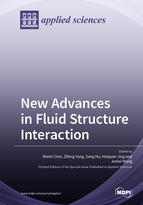New Advances in Fluid Structure Interaction
A special issue of Applied Sciences (ISSN 2076-3417). This special issue belongs to the section "Fluid Science and Technology".
Deadline for manuscript submissions: closed (22 February 2022) | Viewed by 28386
Special Issue Editors
Interests: fluid structure interaction; flow control; bridge wind engineering
Special Issues, Collections and Topics in MDPI journals
Interests: hemodynamics; biomechanics; aneurysm; stenosis; In vitro experiment; computational fluid dynamics
Special Issues, Collections and Topics in MDPI journals
Interests: wind engineering; fluid structure interaction; machine learning; deep learning
Interests: fluid structure interaction; bridge wind engineering
Special Issues, Collections and Topics in MDPI journals
Interests: piezoelectric energy harvesting; flow-induced vibrations; energy harvesting from flow phenomena
Special Issues, Collections and Topics in MDPI journals
Special Issue Information
Dear Colleagues,
Fluid–structure interactions (FSI) are a crucial consideration in the design of many engineering systems, e.g., automobiles, aircraft, spacecraft, engines, pipes, offshore platforms and bridges. The old Tacoma Narrows Bridge (1940) is probably one of the most infamous examples of large-scale failure due to FSI. Aircraft wings and turbine blades can break due to FSI oscillations. The dynamics of reed valves used in two-stroke engines and compressors are governed by FSI. The act of "blowing a raspberry" is another such example. In addition, FSI must be dealt with in ocean, coastal, offshore and marine engineering in order to design and construct safe and functional marine structures.
The Special Issue is focused on the recent progress of fluid–structure interactions in various scenarios of engineering applications and control schemes, which can either mitigate the flow induced motions or harvest energy by enhancing the motion amplitude.
We would like to invite you to contribute a paper to this Special Issue, which aims to collect the most recent and cutting-edge developments on these relevant issues. We welcome papers providing original results on theoretical studies as well as numerical or experimental applications regarding the abovementioned, or closely related, topics.
Prof. Dr. Wenli Chen
Dr. Zifeng Yang
Prof. Dr. Gang Hu
Dr. Haiquan Jing
Prof. Dr. Junlei Wang
Guest Editors
Manuscript Submission Information
Manuscripts should be submitted online at www.mdpi.com by registering and logging in to this website. Once you are registered, click here to go to the submission form. Manuscripts can be submitted until the deadline. All submissions that pass pre-check are peer-reviewed. Accepted papers will be published continuously in the journal (as soon as accepted) and will be listed together on the special issue website. Research articles, review articles as well as short communications are invited. For planned papers, a title and short abstract (about 100 words) can be sent to the Editorial Office for announcement on this website.
Submitted manuscripts should not have been published previously, nor be under consideration for publication elsewhere (except conference proceedings papers). All manuscripts are thoroughly refereed through a single-blind peer-review process. A guide for authors and other relevant information for submission of manuscripts is available on the Instructions for Authors page. Applied Sciences is an international peer-reviewed open access semimonthly journal published by MDPI.
Please visit the Instructions for Authors page before submitting a manuscript. The Article Processing Charge (APC) for publication in this open access journal is 2400 CHF (Swiss Francs). Submitted papers should be well formatted and use good English. Authors may use MDPI's English editing service prior to publication or during author revisions.
Keywords
- fluid–structure interaction
- flow induced vibration and control
- energy harvesting from flows
- aerodynamic optimization and its engineering applications
- vibration suppression via flow control methods
- bluff-body wake and control
- AI-based flows and control
- feedback flow control
- feedforward flow control









